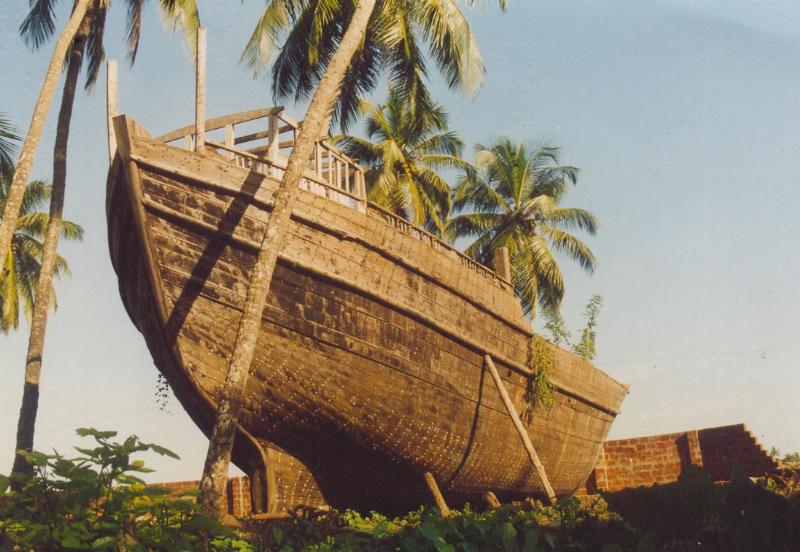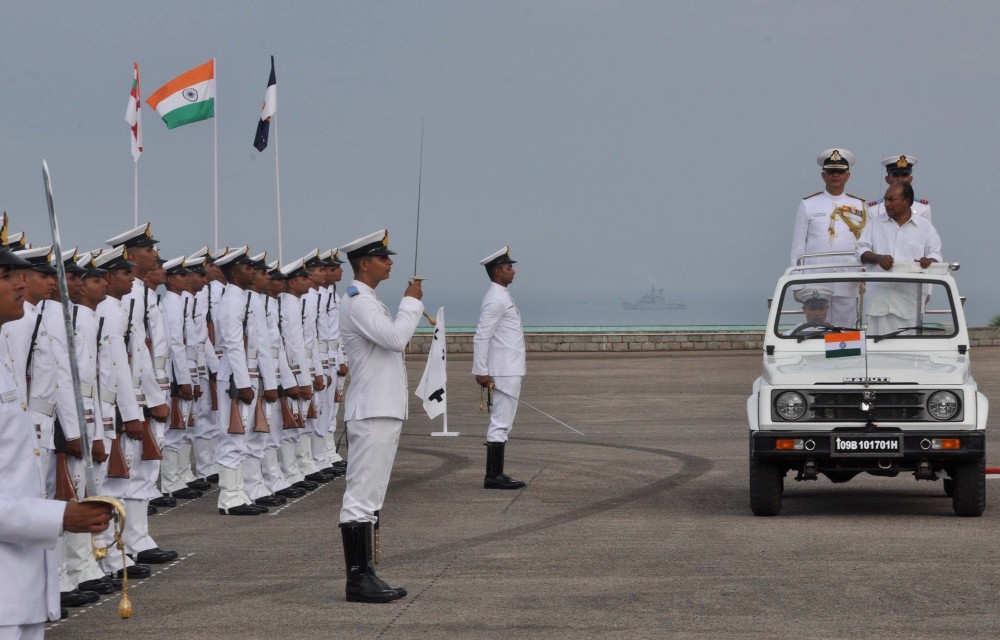|
Thundi
Kadalundi is a village in Kozhikode district, Kerala, India. It is a coastal village close to the Arabian Sea. Kadalundi is famous for its bird sanctuary, which is home to various migratory birds during certain seasons and has been recently declared as a bio-reserve. The Kadalundi-Vallikkunnu community reserve is the first community reserve in Kerala. The Kadalundi River and the Chaliyar river, two of the longest rivers of Kerala, merges with the Arabian Sea at Kadalundi. The first railway line in Kerala was laid in 1861 from Tirur to Chaliyam through Tanur, Parappanangadi, Vallikkunnu, and Kadalundi. Kadalundi panchayat shares the borders with Kozhikode corporation and feroke municipality.kadalundi is a part of kozhikode urban area master plan. History Kadalundi-Chaliyam-Beypore region had trade relations with foreign countries like Rome and Arabia. Tyndis was a major center of trade, next only to Muziris, between the Cheras and the Roman Empire.Coastal Histories: Society and ... [...More Info...] [...Related Items...] OR: [Wikipedia] [Google] [Baidu] |
Vallikkunnu
Vallikkunnu is a village in Tirurangadi Taluk of Malappuram district in the state of Kerala, India with an area of 25 km2. It is located 5 km north of Parappanangadi town and comes under the jurisdiction of Parappanangadi Police Station and Parappanangadi Judicial First Class Magistrate Court. Its latitude and longitude are 11'07" N and 7'51"E respectively. Vallikkunnu was awarded the best panchayath of Kerala in 1997. Vallikunnu is situated on Tirur-Kadalundi Road. Vallikkunnu is also a part of the Oldest Railway Line of Kerala laid in 1861 from Tirur to Chaliyam via Tanur, Parappanangadi, Vallikkunnu, and Kadalundi. Vallikkunnu lies on the bank of Kadalundi River. Kadalundi River joins with Arabian Sea at the estuary (''Azhimukham'') in Kadalundi Nagaram beach of Vallikkunnu Grama Panchayat. Kadalundi Bird Sanctuary and Kadalundi-Vallikkunnu Community Reserve are located here. Demographics India census, Vallikkunnu had a population of 22853 with 11057 males ... [...More Info...] [...Related Items...] OR: [Wikipedia] [Google] [Baidu] |
Kozhikode District
Kozhikode (), or Calicut district, is one of the 14 districts in the Indian state of Kerala, along its Southwestern Malabar Coast. The city of Kozhikode, also known as Calicut, is the district headquarters. The district is 67.15% urbanised. The Kozhikode Municipal Corporation has a corporation limit population of 609,224 and a metropolitan population of more than 2 million, making Kozhikode metropolitan area the second-largest in Kerala and the 19th largest in India. Kozhikode is classified as a Tier 2 city by the Government of India. NIT Calicut and IIM Kozhikode are two institutions of national importance located in the district. Kozhikode is the largest city in the erstwhile Malabar District and acted as its headquarters during British Raj. In antiquity and the medieval period, Kozhikode was dubbed the ''City of Spices'' for its role as the major trading point for Indian spices. It was the capital of an independent kingdom ruled by the Samoothiris (Zamorins), which ... [...More Info...] [...Related Items...] OR: [Wikipedia] [Google] [Baidu] |
Kozhikode
Kozhikode (), also known in English as Calicut, is a city along the Malabar Coast in the state of Kerala in India. It has a corporation limit population of 609,224 and a metropolitan population of more than 2 million, making it the second largest metropolitan area in Kerala and the 19th largest in India. Kozhikode is classified as a Tier 2 city by the Government of India. It is the largest city in the region known as the Malabar and was the capital of the British-era Malabar district. In antiquity and the medieval period, Kozhikode was dubbed the ''City of Spices'' for its role as the major trading point for Indian spices. It was the capital of an independent kingdom ruled by the Samoothiris (Zamorins). The port at Kozhikode acted as the gateway to medieval South Indian coast for the Chinese, the Persians, the Arabs and finally the Europeans. According to data compiled by economics research firm Indicus Analytics in 2009 on residences, earnings and investments, Kozhikode w ... [...More Info...] [...Related Items...] OR: [Wikipedia] [Google] [Baidu] |
Ezhimala
Ezhimala, a hill reaching a height of , is located near Payyanur, in Kannur district of Kerala, south India. It is a part of a conspicuous and isolated cluster of hills, forming a promontory, north of Kannur (Cannanore). The Indian Naval Academy at Ezhimala is the Asia's largest, and the world's third-largest, naval academy. As the former capital of the ancient Kolathunadu Kingdom of the Mushikas, Ezhimala is considered to be an important historical site. A flourishing seaport and center of trade around the beginning of the Common Era, it was also one of the major battlefields of the Chola- Chera Wars, in the 11th century. It is believed by some that Buddha had visited Ezhimala. The Kolathunadu (Kannur) Kingdom at the peak of its power, reportedly extended from Netravati River (Mangalore) in the north to Korapuzha (Kozhikode) in the south with Arabian Sea on the west and Kodagu hills on the eastern boundary, also including the isolated islands of Lakshadweep in the Arabian Sea ... [...More Info...] [...Related Items...] OR: [Wikipedia] [Google] [Baidu] |
North Malabar
North Malabar refers to the geographic area of southwest India covering the state of Kerala's present day Kasaragod, Kannur, and Wayanad District, Wayanad districts, and the taluks of Vatakara, Koyilandy, and Thamarassery in the Kozhikode District of Kerala and the entire Mahé, India, Mahé Sub-Division of the Puducherry (union territory), Union Territory of Puducherry. Traditionally North Malabar is defined as the northern portion of erstwhile Malabar District which lies between Payaswini, Chandragiri River and Korapuzha River. The region between Netravathi River and Payaswini, Chandragiri River, which included the portions between Mangalore and Kasaragod, are also often included in the term North Malabar, as the Kumbla dynasty in the southernmost region of Tulu Nadu (between Mangalore and Kasaragod), had a mixed lineage of Malayali Nairs and Tuluva Brahmins. The North Malabar region is bounded by Dakshina Kannada (Mangalore) to north, the hilly regions of Kodagu and Mysore Pla ... [...More Info...] [...Related Items...] OR: [Wikipedia] [Google] [Baidu] |
Pliny The Elder
Gaius Plinius Secundus (AD 23/2479), called Pliny the Elder (), was a Roman author, naturalist and natural philosopher, and naval and army commander of the early Roman Empire, and a friend of the emperor Vespasian. He wrote the encyclopedic ''Naturalis Historia'' (''Natural History''), which became an editorial model for encyclopedias. He spent most of his spare time studying, writing, and investigating natural and geographic phenomena in the field. His nephew, Pliny the Younger, wrote of him in a letter to the historian Tacitus: Among Pliny's greatest works was the twenty-volume work ''Bella Germaniae'' ("The History of the German Wars"), which is no longer extant. ''Bella Germaniae'', which began where Aufidius Bassus' ''Libri Belli Germanici'' ("The War with the Germans") left off, was used as a source by other prominent Roman historians, including Plutarch, Tacitus and Suetonius. Tacitus—who many scholars agree had never travelled in Germania—used ''Bella Germani ... [...More Info...] [...Related Items...] OR: [Wikipedia] [Google] [Baidu] |
Roman Empire
The Roman Empire ( la, Imperium Romanum ; grc-gre, Βασιλεία τῶν Ῥωμαίων, Basileía tôn Rhōmaíōn) was the post-Republican period of ancient Rome. As a polity, it included large territorial holdings around the Mediterranean Sea in Europe, North Africa, and Western Asia, and was ruled by emperors. From the accession of Caesar Augustus as the first Roman emperor to the military anarchy of the 3rd century, it was a Principate with Italia as the metropole of its provinces and the city of Rome as its sole capital. The Empire was later ruled by multiple emperors who shared control over the Western Roman Empire and the Eastern Roman Empire. The city of Rome remained the nominal capital of both parts until AD 476 when the imperial insignia were sent to Constantinople following the capture of the Western capital of Ravenna by the Germanic barbarians. The adoption of Christianity as the state church of the Roman Empire in AD 380 and the fall of the Western ... [...More Info...] [...Related Items...] OR: [Wikipedia] [Google] [Baidu] |
Muziris
Muziris ( grc, Μουζιρίς, Old Malayalam: ''Muciri'' or ''Muciripattanam'' possibly identical with the medieval ''Muyirikode'') was an ancient harbour and an urban centre on the Malabar Coast. Muziris found mention in the ''Periplus of the Erythraean Sea'', the bardic Tamil poems and a number of classical sources."Archaeologist calls for excavations at Kodungalloor". ''The Hindu'' adras 5 August 2011. Web/ref>"KCHR asked to hand over Pattanam excavation". ''ibnlive.in.com'' CNN-IBN, 16 November 2011. Web/ref> Etymology The derivation of the name "Muziris" is said to be from the native Dravidian languages, Dravidian name of the port, "Muciri" (Tamil: முசிறி, Malayalam: മുചിറി). In the region, Periyar river perhaps branched into two like a cleft lip (an abnormal facial development) and thus gave it the name "Muciri.", again a speculation. It is frequently referred to as ''Muciri'' in Sangam poems, ''Muracippattanam'' in the Sanskrit epic ''Ram ... [...More Info...] [...Related Items...] OR: [Wikipedia] [Google] [Baidu] |
Tyndis
Tyndis ( grc, Τύνδις) was an ancient Indian seaport/harbor-town mentioned in the Graeco-Roman writings. According to the ''Periplus of the Erythraean Sea,'' Tyndis was located north of port Muziris in the country of the Cerobothra (present-day Kerala).Gurukkal, R., & Whittaker, D. (2001). In search of Muziris. ''Journal of Roman Archaeology,'' ''14'', 334-350. Previously, Tyndis was attributed to Thondi, a region ruled by the Pandya country in present day Tamil Nadu. Alternatively, the Cheras of the early historical period (c. second century BCE - c. third century CE) are known to have had their original centre at Karur in interior Tamil Nadu and harbours at Muziris and Tyndis on the Malabar coast (Kerala). Tyndis was a satellite feeding port to Muziris, according to the Periplus. It was a major center of trade, next only to Muziris, between the Cheras and the Roman Empire.Coastal Histories: Society and Ecology in Pre-modern India, Yogesh Sharma, Primus Books 2010 Pliny ... [...More Info...] [...Related Items...] OR: [Wikipedia] [Google] [Baidu] |
Beypore
Beypore or Beypur (formerly Beypoor) is an ancient port town and a locality town in Kozhikode district in the state of Kerala, India. It is located opposite to Chaliyam, the estuary where the river Chaliyar empties into Arabian Sea. Beypore is part of Kozhikode Municipal Corporation. The place was formerly known as Vaypura / Vadaparappanad and also as Beydary. Tippu Sultan, ruler of Mysore, named the town "Sultan Pattanam". There is a marina and a beach while ''Beypore port'' is one of the oldest ports in Kerala, which historically traded with the Middle East. Beypore is noted for building wooden ships, known as ''dhows'' or ''urus'' in the Malayalam language. These ships were usually bought by Arab merchants for trading and fishing but are now used as tourist ships. According to Captain Iwata, founder member of the Association of Sumerian ships in Japan, Sumerian ships might have been built in Beypore. There is evidence to prove that Beypore had direct trade links with Mesopotami ... [...More Info...] [...Related Items...] OR: [Wikipedia] [Google] [Baidu] |
Periplous Of The Erythraean Sea
A periplus (), or periplous, is a manuscript document that lists the ports and coastal landmarks, in order and with approximate intervening distances, that the captain of a vessel could expect to find along a shore. In that sense, the periplus was a type of log and served the same purpose as the later Roman itinerarium of road stops. However, the Greek navigators added various notes, which, if they were professional geographers, as many were, became part of their own additions to Greek geography. The form of the ''periplus'' is at least as old as the earliest Greek historian, the Ionian Hecataeus of Miletus. The works of Herodotus and Thucydides contain passages that appear to have been based on ''peripli''. Etymology ''Periplus'' is the Latinization of the Ancient Greek, Greek word περίπλους (''periplous'', contracted from περίπλοος ''periploos''), which is "a sailing-around." Both segments, ''peri-'' and ''-plous'', were independently Productivity (linguistics ... [...More Info...] [...Related Items...] OR: [Wikipedia] [Google] [Baidu] |







